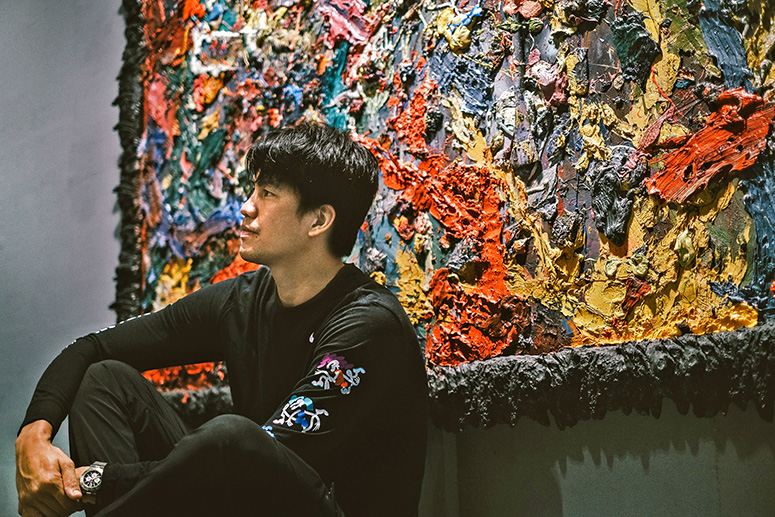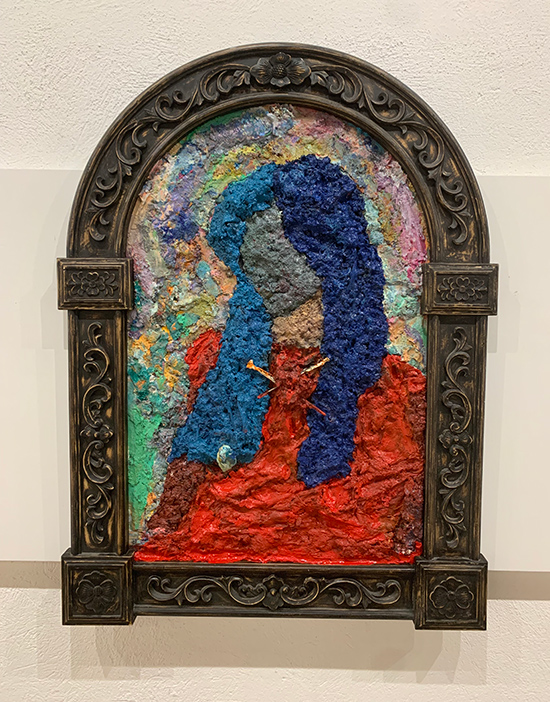JC Intal : Rookie no more
The fast break of JC Intal into the art world was unexpected — even to himself. It was not only a different court from the one where he showcased his athletic dexterity for more than half of his life; it was also perceived to be notoriously insular and outlandishly snobbish.
So when a gallery approached him for a solo exhibition to fill in a canceled slot, Intal approached the idea with much trepidation. The paintings he was doing at this time were the private forays of a novice. And besides, he was still playing professional basketball.
Nervous, hesitant, and aware that he still had so much to learn, Intal found encouragement from family and friends, ultimately biting the bullet. Titled “Rookie Mistake,” his first solo show revealed large-scale works teeming with impasto — vast fields bristling with multicolored strokes.
As an homage to the sport that made his name, he also exhibited basketball shoes splattered with paint. They were nothing but symbolic: the cager was about to cross a threshold into a different discipline.

A month after his exhibit opened, the nationwide lockdown happened. This was 2020, the year of indeterminacy, when the world as we knew it was about to be altered.
The Philippine Basketball Association, beset by postponements, soldiered on with the season, but within the so-called “bubble” that isolated the players from their families and fans. Perplexed about the future of basketball and wanting to spend more time with his wife, TV personality Bianca Gonzalez, and their two daughters, Intal retired.
Art, which started as a hobby, played a central role in Intal’s life. He had a studio constructed adjacent to a family home in a province north of Metro Manila, which he would visit as often as four times a week. It also has enough space for him to spread out his sprawling canvases and form mounds of paint squeezed directly from tubes.
Two-and-a-half years after his first solo show, Intal just launched his third solo exhibition, “Seven Mirrors,” which opened yesterday, Aug. 21, at the Ilustrado room of Gallery 7 of Pintô Art Museum.

Intal is no stranger to Pintô, as his work “Sixteen II,” which measures a staggering seven by nine feet, occupies pride of place at Gallery 7. In fact, the painting has served as a background for many a selfie, something that still amuses Intal.
His current show, situated in the largest exhibiting space at Pintô, presents new works that not only crystallize the abstract gesture but capture the essence of an individual, evoked by the silhouette emerging from the hectic background of the painting.
In a way, these works are also self-portraits. After all, the figures are emblematic of the traits that Intal has assimilated from those whose influence on him is both indelible and lasting. Because they are rendered in a non-objective manner, the viewer can also see these figures as reflections of themselves and, simultaneously, the people who have shaped them.
While his previous shows demonstrated pure abstraction with the impromptu application of paint, Intal (who appends the number 7 after his surname as a nod to his basketball roots), flirts with figurative possibilities, as a way to approach portraiture through non-representational terms.
The discernible human outlines in his works represent the people who have been instrumental to his growth. Without their presence, he would have been a different person living a totally different life. As Intal puts it: “We are the sum of all the people we have met.”

In a way, these works are also self-portraits. After all, the figures are emblematic of the traits that Intal has assimilated from those whose influence on him is both indelible and lasting. Because they are rendered in a non-objective manner, the viewer can also see these figures as reflections of themselves and, simultaneously, the people who have shaped them.
Further extending this point, Intal has used the ornate frames of antique mirrors to display these abstract portraits, emphasizing that the self is also (the result of) the other.
Color, which reigns supreme in Intal’s works, is not only visual but tactile, responsive to the conditions of the environment. The impasto, which rises thickly and confidently from the surface, renders a kind of second skin onto the painting: intervening with the sources of illumination, playing with shadow and light.
More than anything, it is the sheer, unbridled exuberance with which the artist engages with his material that is instantly recognizable. “When I’m here in my studio, I feel like I’m on a basketball court,” he shares. “The joy is different.”
This is why Intal doesn’t see art as a form of work, but something that puts him in a zone, where he can create with utmost freedom and invest his full attention to his craft.
“Art is vast,” he says. “Because of it, I have learned so many things and interacted with so many people.” If anything, Intal is proof that the art world can be inclusive and welcoming, and not the exclusive and pretentious space that some people have made it out to be.
In addition, his third solo show affirms that with discipline and motivation, traits that no doubt Intal has cultivated through sport, growth can be prompted. While the artist admits that there is still so much ground to cover, “Seven Mirrors” testifies that Intal is a rookie no more.
The exhibit presents a fresh approach, in which paint becomes a supple instrument in the hands of the artist, assumes a sculptural quality, and is molded to reference something in the world — something that is treasured and beloved.* * *
“Seven Mirrors” is on view at until Sept. 18 and included in regular admission. Pinto Art Museum is located at 1 Sierra Madre Street, Grand Heights Subdivision, Antipolo City. For inquiries, contact Jenny Villanueva at 0927-764-6270 or pintoartmuseum@yahoo.com.



